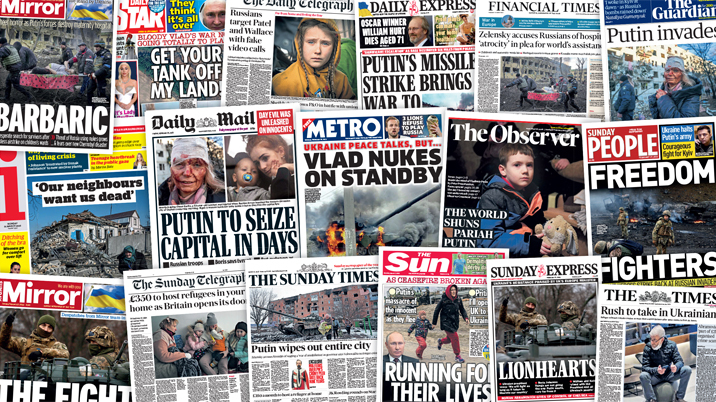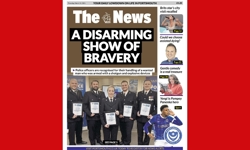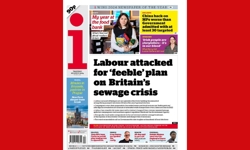
On April 9, 2003, American tanks rolled into Baghdad. Saddam Hussein was in hiding and an emboldened crowd tied a rope around his statue, pulled it down, then started beating it with slippers – which we soon learnt was the greatest insult an Iraqi can deliver.
Sitting on a Fleet Street backbench, the choice of picture for the next day’s paper was relatively easy. There were three candidates: the statue as it was being pulled down, an American soldier putting a US flag on Saddam’s head, or – the one we went with at The Times – a US Marine looking over his shoulder at the statue, by then at 90° to its plinth.
For the tabloids, the headline was easy too: the Sun and Mirror went with ‘Statue of liberty’, the Mail and Express a single word: ‘Toppled’. Both the Guardian and Telegraph took a similar approach, with ‘The toppling of Saddam’. But we at The Times just had to be different. Heaven knows why we couldn’t have gone with the obvious. I remember the duty editor sitting at my side, agonising over a form of words that would capture the historic nature of the day. We ended up with ‘Victory in the 21 day war’. Well, that aged well, didn’t it?
I didn’t like it then – and not because of any prescience that our troops would be in Iraq for years – and I still cringe to think of it now. I daresay its author is none too proud of it either. The point of this anecdote is not to reopen old wounds, but to point up one of the pitfalls of covering a war: latching on to a single dramatic event and over-egging it to imbue it with a significance that may not be borne out in retrospect.
This is true of all journalism to some extent; we are very fortunate if we recognise a turning point at the moment it happens. We may think we’ve spotted one and say, “things will never be the same again” and then they revert to normal – and then we go and miss the removal of the single domino that brings a whole edifice crashing down.
War is thankfully so alien to us that the dangers of misinterpretation are magnified – just when there is the greatest duty to get it as right as possible. So how do we go about that? Like the armies who are doing the real fighting: by marshalling our forces to maximise our strengths and calling in reinforcements to limit our weaknesses.
Foreign editors have to be super-mindful of their correspondents’ physical safety and mental health.
The role of the foreign editor
The war correspondent is the legendary journalistic hero – even down to poor old Boot in Scoop. He or – more frequently these days – she is the one putting themselves in danger. But it is foreign editors, directing operations from the office, who carry the heaviest load. They not only have to make sure that people in the field have the right equipment and documentation and that they are in the right place, but they have to be super-mindful of their correspondents’ physical safety and mental health, to pick up signals that they might be putting themselves at too much risk or under too much strain.
They also have to oversee the overall coverage – first-person stuff from on the spot is what everyone wants to read, but we also need an oversight of the entire conflict and the geopolitics. And that comes from the office – from the political team, the defence editor, the diplomatic editor, as well as foreign correspondents in the key capitals and at the UN. We also need expert analysis and interpretation, so reliable voices from outside the office have to be found.
There is a huge reliance on stringers – both in the warzone and in the offices at home and abroad.
Lack of resources
At the time of the Iraq war, the Times had at least ten staffers in the Gulf, as well as all those people in London. It has just two in Ukraine – plus the bonus of the veteran war photographer Jack Hill, a luxury few others enjoy. Former foreign editor Martin Fletcher says: “They probably sent more people to China in advance of the 2008 Olympics.” The one improvement on those days, Fletcher adds, is that communications are much better now.
This depletion of resources is the same for everyone. All newspaper staffing has been cut to the bone over the past 20 years, so that there is a huge reliance on stringers – both in the warzone and in the offices at home and abroad. What’s more, the workload has increased, with not only a print deadline to meet, but the constant demand to feed the online beast, not to mention tweets, podcasts, videos.
There has been a huge black hole where the true Russian perspective should be.
A partial picture
There are two million refugees in Poland, but who is there to tell that story? And there is, of course, no reliable source of information on what is happening in Russia. The news reader Marina Ovsyannikova’s public dissent made every front page and we know that she was arrested and fined 30,000 roubles. We saw her as a heroine, we feared for her safety and wondered how she could stay in the country. But we had absolutely no way of knowing how many Russians saw her protest or what impact it made in her home country.
There has been speculation about Putin’s health and his and foreign minister Sergey Lavrov’s pronouncements have been analysed to within an inch of their lives. But random interviews with people on the street brave enough to express a counter view cannot be taken as representative of what the nation thinks, so there has been a huge black hole where the true Russian perspective should be.
Even with such constraints and the diminished workforce, the war (or any huge running story – Covid was the same) generates far more copy than could ever be accommodated in print. The web may have infinite space, but you still need the subs to process and upload the material – and their numbers have been cut even more ruthlessly than those of any other department.
You end up with a surfeit of war reports followed by a disproportionate amount of fluff.
Finding the right balance
And that’s where the next pitfall lies: in balancing your product. War is good for business, bringing in sales and increased audiences as people who might not generally care much about world affairs come into the fold. You have lots to say about the war, but you also want to cater for those with gloom fatigue – which is most people after six years of Brexit and pandemic – and, from a commercial imperative, showcase all the other wonderful things you do to encourage your new audience to stick with you.
For the first two weeks after the invasion, most papers allowed their Ukraine coverage to run straight through from the front, with only the Telegraph offering different fare on pages 2 and 3 from the word go. Gradually, all titles pushed the conflict pages back in the book and other subjects appeared on the fronts, while broadcasters, with the advantage of live footage, stuck with Ukraine. On the day P&O sacked 800 workers by Zoom and Nazanin Zaghari-Radcliffe came home, the BBC news had film from Kharkiv, Mariupol and Odesa, plus a political assessment from John Simpson before reporting on the domestic news. There was room for only three stories – the ferries, Nazanin and inflation – before it was back to Ukraine.
This was far from a fair reflection of the day’s events at home and abroad – even Covid, with numbers of infections soaring on the eve of the lifting of all travel restrictions, didn’t get a mention. But time isn’t elastic and when you’ve invested licence-fee payers’ money in sending reporters and camera crews to Ukraine, you want to air every offering.
If you want to know how the Lords voted on the Nationalities Bill, Twitter will offer you more information than the Telegraph.
Missing other stories
Newspapers are in a better position on this – paradoxically, partly because the staffing cuts mean there are slightly fewer conflict reports competing for space than during the Iraq and Afghanistan wars. They still have room for other material. But what other material? When you have three or four war spreads and possibly another on the coronavirus, you need something to leaven the mix. And so you end up with a surfeit of war reports followed by a disproportionate amount of fluff, leaving the reader bloated but unsatisfied from too much stodge, too much pud and too few green vegetables. By that, I mean the good-for-you (as opposed to feelgood) stories on serious issues; matters of policy and society.
This is wonderful for politicians who want to escape scrutiny, brushing aside challenges on almost any topic with today’s equivalent of “Don’t you know there’s a war on?” But it’s not good for democracy.
Important legislation has been working its way through parliament in recent weeks, bills that affect people’s right to live here, to protest, to use the internet. The government has suffered setbacks in some aspects of its legislative programme and has made progress in others, yet all of this has gone largely unreported by mainstream news outlets. If you want to know how the Lords voted on the Nationalities Bill, Twitter will offer you more information than the Telegraph.
Details of the UK Shared Prosperity Fund are due to be published about now. This is supposed to spell out how EU subsidies to the regions will be replaced. There will be winners as part of the “levelling up” process and there will doubtless be some big losers. But how many people have even heard of it? Regional papers like the Western Mail and Yorkshire Post have been watching developments, as have Scottish editions of the nationals, but the London nationals – the FT and online-only Independent aside – haven’t gone near it.
This stuff is important and it is being lost under cover of war, virtue-signalling refugee appeals and pictures of the Duchess of Cambridge.
This stuff is important and it is being lost under cover of war, virtue-signalling refugee appeals and pictures of the Duchess of Cambridge.
Adrenalin rush
And as to all that war reporting – all those UN meetings, phone calls between leaders, even the human interest stories – how much is actually being read? I’ve been here, through the decline of the Soviet empire, the fall of the Berlin Wall, the Gulf War, the Balkans, Iraq, Afghanistan, Chechnya, the “colour” revolutions. When you’re putting a paper together, these stories are intoxicating. They dominate your life and you can’t get enough of them (I was absolutely hooked on Gulf FM), so you assume the reader shares your obsession. Most don’t. However brilliant the writing.
For those who do, there has been some excellent reporting out of Ukraine, on screen and in print. Channel 4’s Lindsey Hilsum is fantastic; Thomas Friedman of the New York Times and Lawrence Freedman in the New Statesman are worth your time. Anthony Loyd in the Times is probably the best war correspondent working today and Henry Foy in the FT is another must-read. Security expert Fiona Hill pops up all over the place – from Politico to the Economist and the Scotsman – and knows what she’s talking about. The list goes on and on.
So, if you want to know about the Ukraine war, go for the heavyweights; if you want to know about kind-hearted Brits and royals, go for the tabloids; if you want to know about day-to-day policy developments, sadly, your best bet is social media.
And never forget that when war breaks out, no matter how hard reporters strive to bring us the truth – and, by golly, they do – everything you see or hear is what someone on one side or the other wants you to see or hear. Keep your wits about you and good luck!
When you’re putting a paper together, these stories are intoxicating. They dominate your life and you can’t get enough of them.
This article was first published in InPublishing magazine. If you would like to be added to the free mailing list, please register here.












